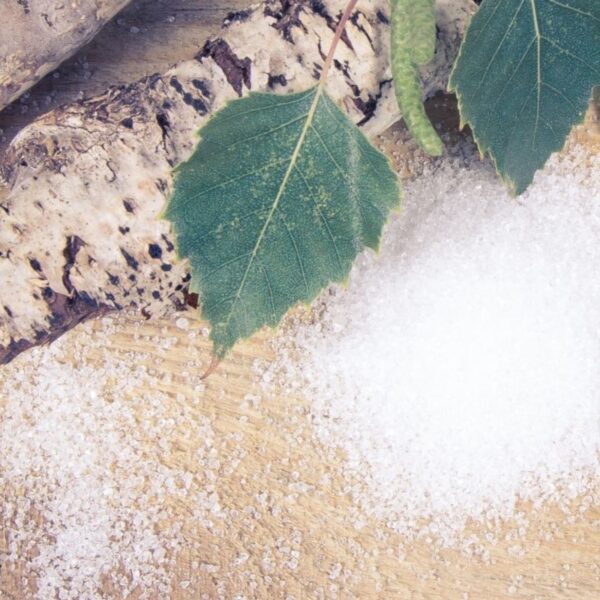Sodium ferrocyanide, also known as the yellow prussiate of soda, is a cyanide salt used as an anti-caking agent to maintain the free-flowing properties of table salts. It forms beautiful, translucent yellow crystals. This article illustrates sodium ferrocyanide’s significance, properties, applications, and safety concerns.
What is Sodium Ferrocyanide?
Sodium ferrocyanide is a sodium salt of a coordination compound with formula [Fe(CN)6]4−. This compound is a yellow crystalline solid, soluble in water and alcohol. The yellow color of the compound comes from the ferrocyanide anion. Sodium ferrocyanide is produced industrially from hydrogen cyanide, ferrous chloride, and calcium hydroxide, the combination of which affords Ca2[Fe(CN)6] · 11 H2O. Sodium ferrocyanide can be easily weathered in the air at a temperature between 50-60 ℃ as the crystal will quickly lose the water during crystallization.
Source: Wikipedia
How is Sodium Ferrocyanide Produced?
Sodium ferrocyanide is prepared on an industrial scale by reacting hydrogen cyanide with ferrous chloride and calcium hydroxide with heat. The solution obtained from this reaction is treated with sodium salts and later with sodium carbonate to create sodium ferrocyanide after crystallization.
Use of Sodium Ferrocyanide in Food Industry
Sodium ferrocyanide is commonly used as an anti-caking agent in salts and salt substitutes. Due to contact with atmospheric moisture, table salts can undergo clumping. Adding a certain amount of sodium ferrocyanide can prevent this from occurring. The ferrocyanides are less toxic than many cyanide salts because they tend not to release free cyanide.
The crystals at the surface of table salts are easy to dissolve when exposed to moisture in the environment or during manufacturing. When this moisture evaporates, recrystallization occurs, which causes caking or lumping. Small amounts of sodium ferrocyanide can prevent clumping.
In table salt, sodium ferrocyanide is typically used at around 20 mg/kg concentrations. For other food applications, it’s crucial to consult specific guidelines and formulations based on the type of food product and region.
Product Examples
Here are some examples of products that contain sodium ferrocyanide:
| Food Additives | Salt, Salt Substitute, Citric Acid |
Properties of Sodium Ferrocyanide
| Chemical formula | Na4[Fe(CN)6] |
| Molar mass | 303.91 g/mol |
| Appearance | Pale yellow crystals |
| Odor | Odorless |
| Density | 1.458 g/cm3 |
| Melting point | 435 °C (815 °F; 708 K) (anhydrous)81.5 °C (178.7 °F; 354.6 K) (decahydrate) (decomposes) |
| Solubility in water | 10.2 g/100 mL (10 °C)17.6 g/100 mL (20 °C)39.7 g/100 mL (96.6 °C) |
| Refractive index (nD) | 1.530 |
Recommended Storage and Handling
Sodium ferrocyanide should be stored in a cool, dry place, away from strong acids and oxidizing agents. Handling it with gloves and ensuring good ventilation in the workspace is recommended. Direct exposure or ingestion should be avoided.
Formulation Considerations
Stability
Sodium ferrocyanide is stable at room temperature. Ferrocyanide complexes are generally stable due to the strong bonding between iron and cyanide. No significant structural decomposition occurs in Ferrocyanides at pH as high as 14.
Dosage
In the EU, sodium ferrocyanide, used as a food additive, was previously evaluated by the Scientific Committee on Food (SCF) in 1990. In that evaluation, the SCF agreed with the acceptable daily intake of 0.025 mg/kg body weight per day (calculated as sodium ferrocyanide) established by the Joint FAO/WHO Expert Committee on Food Additives (JECFA) for Sodium Ferrocyanide.
According to the U.S. Food and Drug Administration, using anhydrous sodium ferrocyanide in food and as an adjuvant in drugs should not exceed 13 parts per million.
Effect of Sodium Ferrocyanide in Food Products through Salt
Sodium ferrocyanide is entirely safe for use in salt and salt substitutes. In subsequent food formulations, the salt containing ferrocyanide that is added as the cyanide is strongly attached to the Iron in the complex. Generally, salt producers label the ingredient in their product as Yellow Prussiate of Soda to prevent panic due to cyanide labeling.
Sensory Properties
Sodium ferrocyanide is a neutral yellow crystalline salt and is practically odorless. Adding it to any salt as an anticaking agent or in any food formulation does not influence the taste.
Safety and Regulatory Considerations
According to EU Regulations and the FDA for food additives, sodium ferrocyanide in suggested levels is safe for salts and salt substitutes and is not toxic to the consumer or the environment.
Sodium ferrocyanide was evaluated by a working group established by the Nordic Council of Ministers in 2000 (TemaNord, 2002). Sodium ferrocyanide was not considered to cause a safety problem due to the minimal quantities consumed. It was noted that a complete toxicological evaluation is possible with long-term and reproductive studies.
| FDA Information | Sodium ferrocyanide is approved as a food additive in specified dosages as an anti-caking agent per U.S. FDA Regulations. |
| EU Information | As an anti-caking agent, sodium ferrocyanide is approved for use as a food additive in specified dosages per EU Regulations. For its use in food products, specifically table salt, the acceptable limit set by the European Union is 20 mg/kg. The limits may vary depending on the region and specific application. |
Safety & Toxicity of Sodium Ferrocyanide
There are some concerns regarding using Ferrocyanide as a food additive. Still, sodium ferrocyanide is entirely safe as a food additive at the recommended dosage suggested by the FDA, EU Compliance, and WHO. Ferrocyanides are less toxic than many cyanide salts because they do not release free cyanide.
Identification Numbers
| Chemical Name | Tetrasodium Hexacyanoferrate |
| CAS Number | 13601-19-9 |
| REACH Registration Number | 01-2119974598-15 (for the anhydrous form) |
| EC Number | 237-081-9 |
| INS No. (Food Additive) | 535 |
| CA Index Name | Sodium Ferrocyanide |
Fun Facts About Sodium Ferrocyanide
- Sodium ferrocyanide forms beautiful yellow crystals, which makes it visually striking. This vibrant yellow color has made it a subject of interest among chemists and those intrigued by colorful compounds.
- Sodium ferrocyanide and its related compounds played an essential role in the history of synthetic dyes. The discovery of Prussian blue, a deep blue pigment, resulted from the reaction between the ferrocyanide ion and iron salts.
- Despite containing the word “cyanide” in its name, sodium ferrocyanide is not incredibly toxic. The cyanide within the compound is tightly bound to the iron, making it much less toxic than free cyanide ions.
- Historically, ferrocyanide compounds were used in the photographic industry, especially in the toning of photographs. Photographers would use ferrocyanide and other chemicals to give photos a sepia or blue tone.
- Sodium ferrocyanide can act as an indicator for iron. When added to a solution containing ferrous ions, a brilliant blue color (Prussian blue) forms, indicating the presence of the iron.
- Ferrocyanides can be used in forensic science to detect specific metal residues. The formation of Prussian blue can help detect iron residues in various samples.
- The name “Prussian blue,” which originates from ferrocyanide’s role in the dye’s creation, derives from the compound’s discovery in Prussia in the early 18th century.
- Because of its significance in the history of dyes and pigments, sodium ferrocyanide and its related compounds, like Prussian blue, find mentions in many museums, especially those dedicated to art and chemistry.
Additional Resources
- Food Additives – Sodium Ferrocyanide
- Ataman Chemicals – E535 Sodium Ferrocyanide
- Wikipedia – Sodium Ferrocyanide
- Wego Chemical Group – Global Supplier of Sodium Ferrocyanide
- Ataman Chemicals – Sodium Ferrocyanide
- Haz-Map – Sodium Ferrocyanide
- GACL – Sodium Ferrocyanide PDF
- NSF Par – Sodium Ferrocyanide in Salt
- ResearchGate – Re-evaluation of Sodium Ferrocyanide E 535
- GovInfo – CFR-2019-title21-vol3-chapI.pdf
- Echemi – Sodium Ferrocyanide Market Analysis
- FSSAI – Mythbuster Salt PDF
- EFSA – Journal Publication 5374



